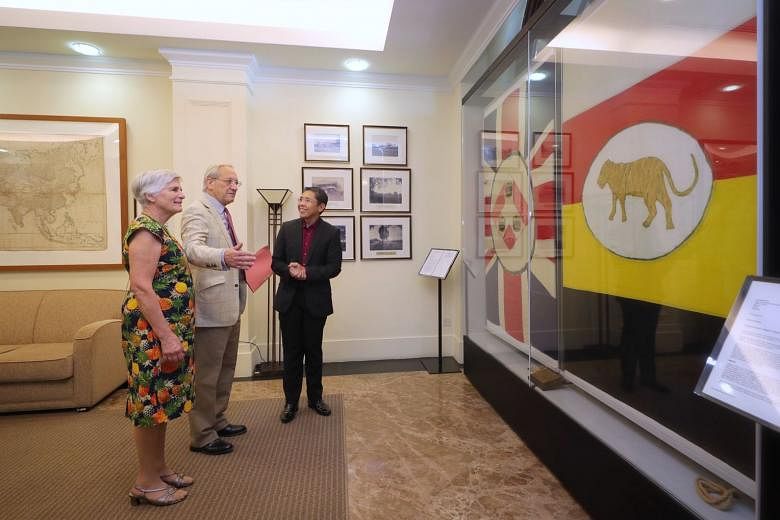For the Sherman family, it was a painful but necessary act of remembrance of father and daughter; for Singapore, it was a reunion with two important artefacts of its wartime heritage.
An informal but touching ceremony held at the Ministry of Foreign Affairs yesterday saw a British couple in their 70s - Mr Nicholas Sherman and his wife Rosemary - setting their eyes for the first time on two colonial flags after they returned them to Singapore in 2012.
The Union flag and the flag of the Federated Malay States were previously in the possession of Mr Sherman's father, Lieutenant-Colonel Geoffrey Sherman, who had been entrusted with them by a British prisoner of war during the Japanese Occupation of Singapore.
The flags had been taken down from their masts at Tanglin Barracks when Japanese forces attacked Singapore in 1942, and hidden in defiance of the occupiers. But they went missing for 20 years after World War II, when crates of Lt-Col Sherman's belongings disappeared en route to London in the post-war confusion.
In the 1960s, the British Royal Marines returned them to Lt-Col Sherman when his trunks were found in its depository.
After Lt-Col Sherman's death, Mr Sherman decided to return the flags to Singapore.
"It's very hard to put into words," said Mr Sherman, when asked how he was feeling. "The whole visit to Singapore this week... has been very emotional. Most of all, I think of my father. This is his occasion, not my occasion."
Lt-Col Sherman organised the Japanese surrender ceremony at City Hall in 1945, and the flags were raised at his funeral in 2009 to mark his involvement in this episode of the region's history.
In a letter he sent to the High Commissioner of Singapore in London in 2012, Mr Sherman wrote: "I know that my father would have been very pleased... indeed that he had done his duty to his colleagues in Singapore who entrusted the flags to him in 1945."
Today, the two flags are on display in glass casings, witnesses to the vagaries of colonialism and war. On the left is the Union flag of the then governor of the Straits Settlements, which included Singapore, Penang and Malacca, territories represented by three imperial crowns set at the centre of the Union Jack.
The flag of the Federated Malay States, on the right, features a Malayan tiger and horizontal stripes of white, red, yellow and black, the predecessor of the flag for the Malayan Union (1946 to 1948), and a flag of the Federation of Malaya that was used from 1948 to 1950.
Mrs Sherman said that apart from their public significance, the two flags had a private meaning for the couple as they prompted reflections on their deaf-blind daughter, who died 11 years ago.
She said: "One of the ladies who was guiding my daughter in a London hospital had been herself a prisoner in Changi jail (during the war). She too had a daughter who was deaf and always attributed her daughter's deafness to her lack of proper nutrition in Changi.
"This occasion makes me reflect on our daughters and this lady as well."
It is only appropriate that the flags are now where they are, Mr Sherman said.
"When they came into my charge, I felt, as did the rest of my family, that it was important they be returned to Singapore. We have not donated them, we have returned them to where they originally belong," he added.
Since arriving in Singapore last Saturday, the couple have been on an emotional tour of Singapore's historic spots, such as City Hall and Sentosa. It was a much overdue visit for Mr Sherman who, raised in Britain, came across his father's Singapore legacy only when he read a 17-page letter his father wrote from Singapore dated Sept 21, 1945.
In it, Lt-Col Sherman detailed to his family his experiences of the war, including the torture of prisoners at Changi Prison by the Japanese.
"He, like most of those from his generation, did not like to talk about the war... (In the letter) were moving stories of the torture the bishop of Singapore suffered and the torture the ordinary members of the public suffered.
"The stories were also of the bravery of local Singaporeans who managed to smuggle food to the prisoners of war in Changi," he said.
Senior Minister of State for Defence and Foreign Affairs Maliki Osman, who received the couple during the visit, said the flags remind Singaporeans of "a difficult past".
"It allows Singaporeans to continue to reflect and appreciate the independence that we have today. We can learn more from the past to see where we can head into the future," he added.


